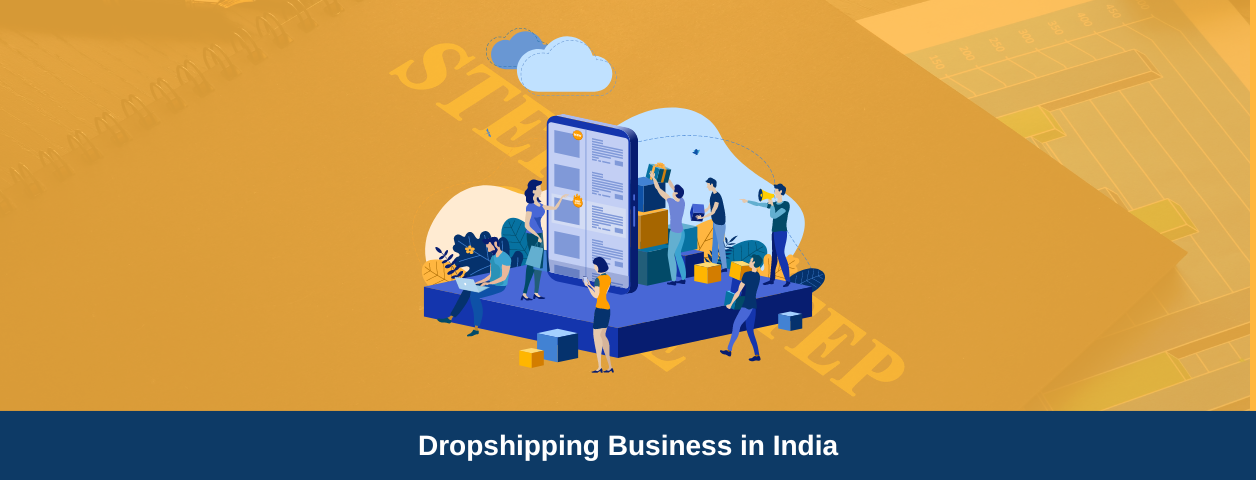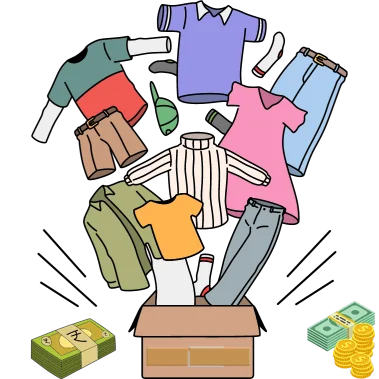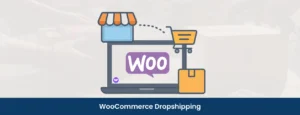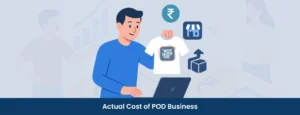Are you looking for a low-cost small business idea? Then dropshipping will be your best bet. With little investment and no inventory costs, one can earn anywhere between ₹20,000 to ₹50,000 per month.
If you are curious about how to start a dropshipping business in India, we have created a step-by-step guide here. By the end of these 8 steps, you will have a blueprint for starting your dropshipping business.
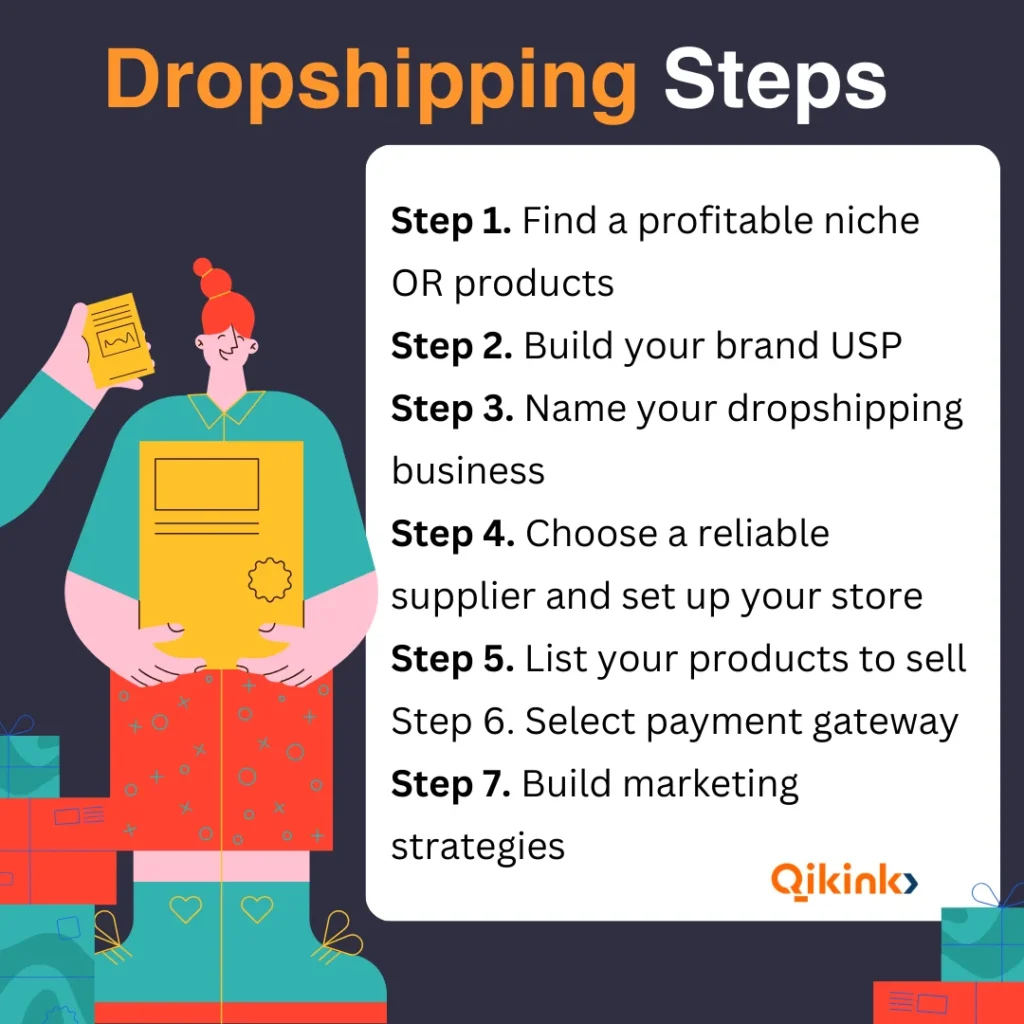
Step 1. Find a profitable dropshipping niche OR products
The success of your dropshipping business depends on factors like:
- The market demand for the products you sell: The demand should be high. Use Google Trends to identify the product trends within its target market.
- How unique or interesting your product is: The more unique or interesting, the better it is. Looking for the product online will give an idea.
- The availability of the product: Rare to find products are more profitable. Search the product on different e-commerce websites to understand its availability.
- The profit margin opportunities on the product: Find the average retail price and the wholesale price. More profit margins are better for sustainable business.
- Product turnover: Low product turnover indicates the popularity of the product. Trending products usually have a low turnover.
- Availability of suppliers: The availability should be moderate. High availability will lower the demand, while low availability can impact the sustainability of your business. There are plenty of marketplaces you can check. Like IndiaMART, TradeIndia, Exporters Indian, and Alibaba
- Having multiple product options: Focusing on a product category, instead of a single product, increases the chances of upselling. For example, if you are selling curtains, you can list other home decor and furnishing items.
Seems too much? Don’t worry, our free dropshipping business template here will help you streamline your product research.
Here’s how it looks.

NOTE: Once you have created a list of possible dropshipping niches, use the above template to prioritze the most profitable and suitable niche idea to proceed further.
Step 2. Build your brand USP
Having a unique selling point (USP) will help you establish your dropshipping business model faster.
Here’s how you can build your USP.
1. Focus on niche & need
Pick a unique niche (think eco-friendly pet toys, activewear for plus sizes) that solves a specific problem for your target audience.
Example: “Empowering women through affordable, stylish activewear that fits and flatters every curve.”
2. Provide value beyond dropshipping
Don’t just resell. Offer curated collections, personalized recommendations, or localized product descriptions.
Example: “Handpicked home decor treasures that add instant charm to your Indian living space.”
3. Have a customer-centric approach
Focus on fast shipping, reliable suppliers, and exceptional post-purchase care.
Example: “Lightning-fast delivery within India, hassle-free returns, and a dedicated customer happiness team.”
In the beginning, you have to experiment with different USPs and see what resonates with your audience. Plus, your USPs should be conveyed through your branding, marketing, and every customer touchpoint.
The first and foremost way to do that will be to craft a clear, concise tagline that captures your essence.
Step 3. Name your dropshipping business
Naming your business right is crucial as a huge portion of your brand identity depends on it. To help you find the right business name, we recommend using Shopify’s free business name generators.
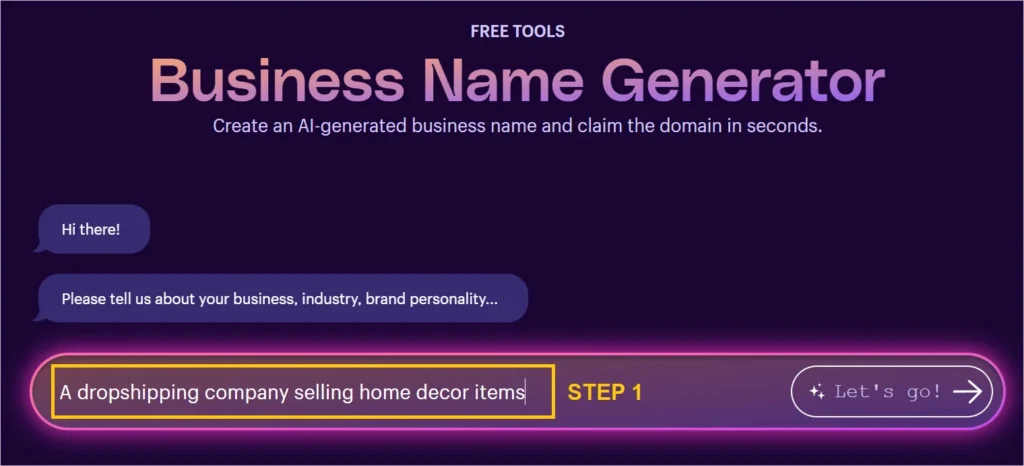
They are more efficient as they save a lot of time and many will show you the availability of domain names for the business name you pick.
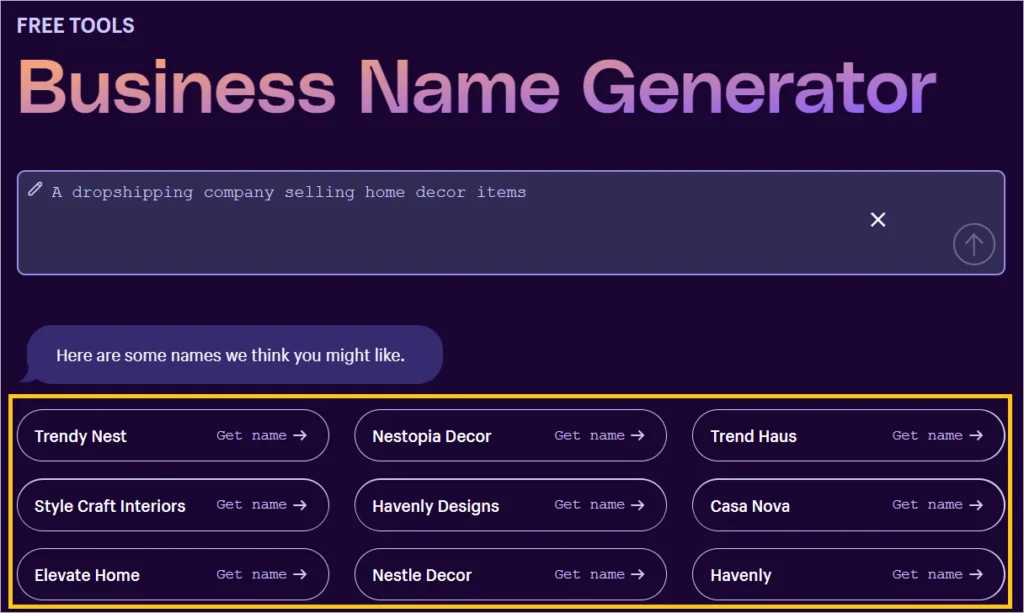
However, to get the best results out of them, here are some tips you should keep in mind.
1. The name should match your business
What vibe does your store give off? Playful pet accessories? “Pawsome Pals” or “Ruffly Royalty” could work.
Or is it sustainable home goods? Then something like “EcoHaven” or “Earthen Abode” will suit you better.
2. Keep it Catchy & Concise
Aim for 2-3 syllables that are easy to spell and remember. Avoid hyphens or tricky pronunciations.
For example, “Wanderlust Threads” is better than “Globetrotter’s Garment Emporium.”

Step 4. Choose a reliable supplier and set up your store
Having a reliable supplier is a must for the long-term success of your business. Here are some reasons that’ll explain this better.
1. Reliable suppliers, means happy customers
Reliable suppliers ensure consistent, high-quality products, avoiding returns, complaints, and damaged reputations. Plus a reliable supplier will provide you with benefits like minimal order wait time and transparent shipping updates. All of which will help you improve your customer’s buying experience.
2. Reliable suppliers make your operations smooth
Reliable suppliers maintain stock availability, preventing order cancellations and lost sales. They are also responsive to communication, so you waste no time. Hence a reliable supplier can be a big part of your USP if you are focusing on a customer-centric approach.
3. Reliable suppliers will build your brand reputation
If your supplier ditches you, you’ll end up cancelling orders, which isn’t a great impression. But with a reliable supplier, you can stop worrying about that.
Reliable suppliers empower you to deliver on your promises, differentiating your brand and attracting repeat business. They will help you make your customers happy and happy customers spread the word, attracting new customers.
For example, Qikink is one of the most reliable suppliers for print-on-demand (POD) businesses.
Here’s why you should look for a reliable business like Qikink:
- We not only have a huge variety to choose from, but they also dispatch orders within 2-3 working days.
- We ship worldwide and deliver your product within 12 working days.
- Unlike other suppliers, there is no minimum order number for our personalized print on demand products.
- With our e-commerce integration you can scale your POD business to the next level.
- At Qikink, we provide free custom branding with your logo on every courier.
- Our delivery and inventory management service allows you to provide COD options to your customers— which helps you increase conversion rate and build trust.
Working with Qikink is hassle-free, too. Just sign up for free and start creating and placing orders by paying for them.
Start your print on demand & dropshipping business
Step 5. Plan and list your products to sell
The steps to plan and list your products for selling vary with platforms. But here’s how you can do it on Qikink. This should give you a brief idea about most other platforms.
- Sign up at Qikink and upload your designs.

- Create products with your designs by going to add products.

- Once you create and save your product it will appear in the My Products section.
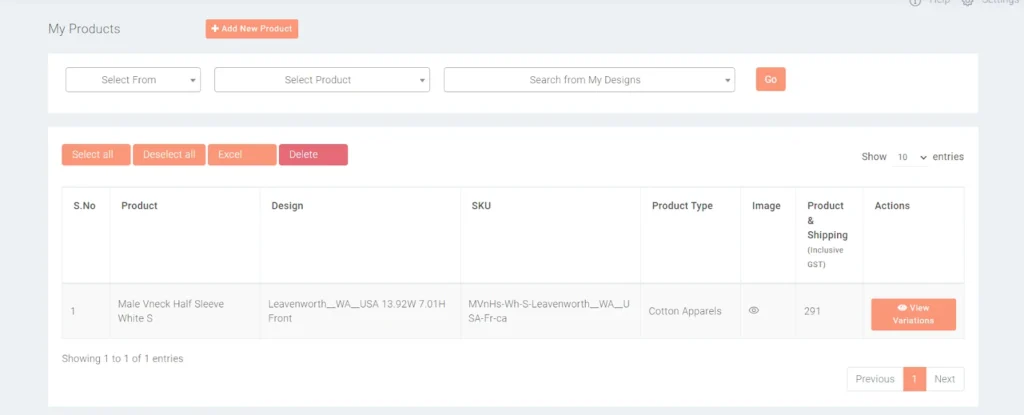
- Now you can use these unique product details on your e-Commerce storefront. The product listing process will also depend on the e-commerce platform you pick. However, make sure to provide detailed product descriptions, high-quality images, and competitive prices.
- After listing on the e-commerce platform sync that inventory with Qikink inventory and the rest of the inventory management gets taken care of by Qikink.
👉 Check out our list of print on demand products available for selling online with zero investment.
Step 6. Select your payment gateway
When choosing a payment gateway, you need to consider quite a few factors. Or else it can affect the functionality and scalability of your business.
So here are 10 things you should look for when choosing the right payment gateway.
- Check things like per-transaction fees, setup charges, and chargeback fees to find the most cost-efficient option.
- Ensure the gateway adheres to the Payment Card Industry Data Security Standard (PCI DSS) to safeguard sensitive customer data.
- Look for features like fraud detection tools, address verification, and 3D Secure authentication to minimize fraudulent transactions.
- It should support major cards like Visa, Mastercard, and American Express. But do have alternative payment methods like PayPal, Apple Pay, Google Pay, Phonepe, etc.
- If you sell internationally, ensure the gateway supports multiple currencies and languages.
- The gateway should integrate seamlessly with your dropshipping platform.
- Ensure the gateway can handle your expected transaction volume without performance issues.
- Choose a provider with features and services that can scale with your business as it grows.
- Research the gateway’s reputation for reliability, uptime, and security.
- Consider the gateway’s historical chargeback ratio as an indicator of its fraud prevention effectiveness.
👉 If you are clueless, here are the best payment gateways for eCommerce in India you can look into.
Step 7. Build marketing strategies to promote your dropshipping products
Once you set up your online store, you need to promote it well. Otherwise, people won’t be able to discover you and your business won’t grow.
Here are some strategies you can try. But initially, it is better to start with one traffic channel.
- Content marketing: You can attract customers with valuable, informative content like blog posts, articles, and infographics. Think of it as building trust and expertise.
- E-commerce SEO: With this you can optimize your online store to rank higher in search engine results pages, making it easier for potential customers to find you.
- Paid ads (Google ads, social media ads): You can pay to place your ads on search engines like Google or social media platforms like Facebook, targeting specific audiences with tailored messages.
- Influencer marketing: Partner with popular individuals in your niche to promote your products or services to their engaged audience.
- Email marketing: With emails, you can stay connected with your customers and promote new products, sales, and other updates through targeted email campaigns.
- Partnering with existing suppliers and stores: Collaborate with other businesses to cross-promote each other’s products or services. This will expand your reach and help you tap into new audiences.
- PR to get referral traffic: This comprises generating positive publicity through media relations and outreach campaigns. This will encourage others to recommend your business.
- YouTube educational video: You can create informative and engaging videos on YouTube to educate potential customers about your products or services and build trust.
👉 Here are some relevant resources for marketing your brand online:
Step 8. Scale it up
Once you have your business running, you can scale it up by following some rules of thumb.
1. 80/20 rule:
Identify the 20% of products driving 80% of your revenue. Double down on promoting and optimizing these high-performers. To find those products look for factors like profit margin, and conversion rate, and customer reviews.
2. Data-driven testing:
Don’t rely on gut feeling. Use A/B testing to compare product titles, descriptions, images, and pricing for variations of your top sellers. Optimizing based on data can maximize conversions.
3. Double down on winners:
Track traffic source performance like paid ads, SEO, and social media. Allocate more budget and resources to the channels driving the most qualified traffic and conversions.
While focusing on winners, allocate a small budget to test newer channels with potential. You might discover hidden gems.
4. Automate repetitive tasks:
Use social media scheduling tools, ad retargeting, and email automation to free up your time for strategic activities like new product research and channel optimization.
5. Offer incentives for repeat purchases:
Implement loyalty programs, discount codes, and exclusive deals for returning customers. Remember, retention is cheaper than acquisition.
6. Automate order fulfillment:
Partner with dropshipping suppliers like Qikink that offer order automation tools to minimize manual work and increase order processing speed.
How does the Dropshipping business model work?
The dropshipping model is quite simple. You put up a virtual storefront, showcasing products without physically holding inventory.
When a customer makes a purchase, you act as a middleman and send the order to a third-party supplier. This supplier then packages and ships the product directly to the customer under your brand.

(Image source: Oberlo.com)
You earn a profit on the price difference between your sales and the wholesale cost from the supplier.
This streamlined approach minimizes upfront investment, allowing you to test products and scale quickly.
Pros and Cons of Dropshipping
Let’s include the Pros and Cons of the Dropshipping business model.
Pros:
- Fast and easy to start a business online
- No substantial upfront capital is required
- No inventory, logistics hassles,
- Print on Demand and huge possibilities
- Access to the catalog of various suppliers’ products
- Sell profitably without worrying about dead inventory
- Scalable business system
- Option to work from anywhere
- Business can be stopped and started whenever required without overhead expenses
- Easy to quit if it is not generating profits (without any loss).
Cons:
- Profit margins will be lower when compared to an inventory-based model
- Supplier may go out of stock or business
- Quality control issues
- Competition
The pros outweigh the cons. Dropshipping is the best way to start a business for the first time, the online way of doing business with merchandise sales.
How Profitable is Dropshipping in India?
The amount of profit you can make with dropshipping depends on how many products you can sell.
The formula to calculate profit per item = Retail price – the price at which you bought it from the supplier
To calculate the total profit on the product = profit per item X number of products sold
For example, if you sell 330 customized coffee mugs for ₹299 (that start at ₹125 per piece) in a month you will make a profit of ₹57,420 only on that product.
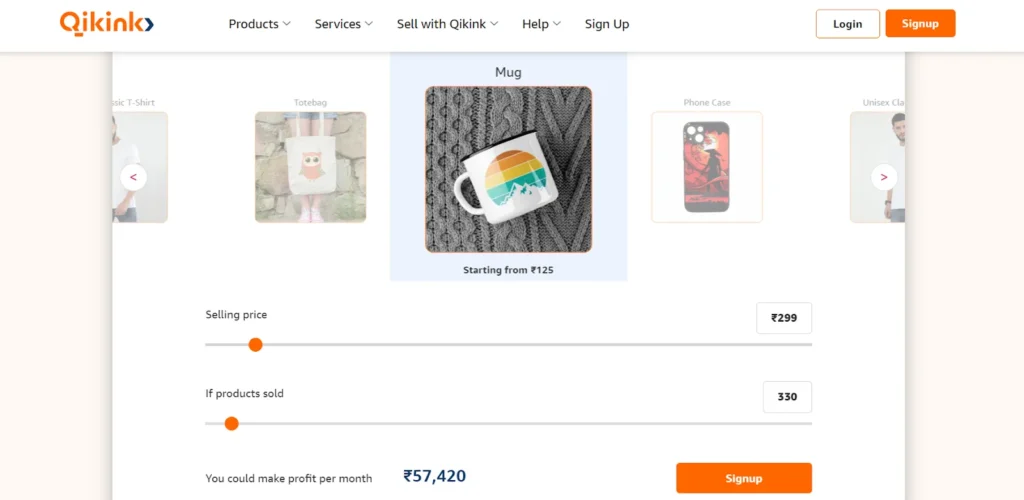
Or, if you are able to sell around 500 customized phone cases for ₹249 (that cost ₹100 each) your total profit on that sale will be around ₹74, 700.
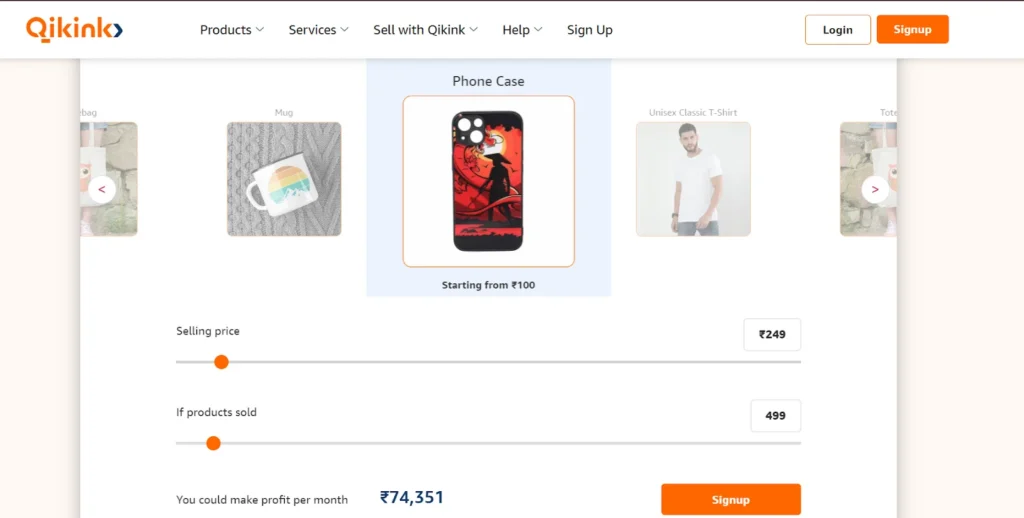
To understand better, try Qikink’s Profit Calculator for free, available on our homepage.
How much does it cost to start a dropshipping business in India?
You will need a small initial investment of ₹8,000- ₹10,000 (excluding paid advertising) or ₹12,000-₹15,000 (including basic marketing tools and some paid advertising) to start a dropshipping business in India.
Let’s look at the cost breakdown.
1. Fixed cost
E-commerce platform:
- Shopify Lite: ₹1,994 per month (annual plan saves you 20%)
- WooCommerce (free plugin, requires hosting):
- Basic hosting: ₹2,000-₹5,000 per year
- Domain name: ₹500-₹1,000 per year
Payment gateway:
- Razorpay: ₹2 per transaction + gateway fees
- Instamojo: ₹2 + 2% per transaction
Design and branding:
- Free logo maker tools available, consider DIYing initially
- Basic product image editing/optimization: ₹500-₹1,000
2. Optional costs
Marketing Tools:
- Email marketing (Mailchimp, Zoho): ₹500-₹1,000 per month
- Social media scheduling tools (Buffer, Hootsuite): ₹200-₹500 per month
Paid advertising:
- Google Ads: Budget varies depending on target keywords and audience. Start with ₹500-₹1,000 per month for experimentation.
- Facebook Ads: Similar to Google Ads, start with a small budget and adjust based on results.
Indian dropshipping market size is estimated at around $1 billion and is expected to grow at a CAGR of 25% in the next 5-7 years. This will make the market size worth $5 billion by 2028.
Therefore this is the best time to get into the dropshipping business.
What are the legal requirements for online dropshipping business in India?
Here are the legal documents and obligations required to start an online dropshipping business in India.
- GST Registration: Goods and Services Tax (GST) registration is mandatory for businesses with annual turnover exceeding ₹40 lakh (except in some special cases). You need to collect and deposit GST on your sales.
Check out our latest blog on this to know more.
- Business Registration: You can register your dropshipping business as a sole proprietorship, partnership firm, or private limited company.
We also suggest opening a separate bank account for your business to track income and expenses and maintain financial clarity.
Start your dropshipping business with Qikink for free
Now that you are all set with the blueprint for a dropshipping business in India, it’s time to put it into action.
Start your dropshipping business with Qikink today. Choose from a wide range of white lable products starting from apparel to home decor at the lowest market rate. Integrate with e-commerce platforms like Shopify and WooCommerce to get automated order processing.
Read more
- How To Start a Dropshipping Business in India – 7 Steps
- Best Dropshipping Suppliers To Boost Your e-Commerce Success
- How to Start Dropshipping Business in Just Few Steps
- Scope Of Dropshipping in India – Opportunities & Challenges in Future
- Is Dropshipping a Profitable Business in India? 10 Key Factors to Consider
Frequently Asked Questions
Why is dropshipping considered a popular business model in India?
To start a dropshipping business is easy as it does not require any inventory management or shipping hassles. You can start dropshipping from your home or any part of the world with a reliable supplier with great quality products. Dropshipping makes it easy to start a product line and also remove products that do not generate sales.
Do I need any specific qualifications or skills to start a dropshipping business?
No, you do not need any specific qualifications or skills to start a dropshipping business. All you need is a laptop and a stable internet connection to start dropshipping business.
How can I find profitable niches and products for my dropshipping store?
You need to conduct thorough research to find the market gaps. Understand your interests and connect them to the market demand. Use tools like Google Trends, Amazon product search tools and Aherf etc to find product demand.
Are there any legal requirements or registrations to start a dropshipping business in India?
There are no legal requirements or registrations to start a dropshipping business in India. However, if you wish to sell on marketplaces, then GST is mandatory to list your products.
How do I identify reliable suppliers or wholesalers for dropshipping in India?
Here are 5 techniques to identify reliable suppliers to start dropshipping
- Google search for best dropshipping suppliers
- Checkout their reviews
- Purchase samples to test their product quality and services
- Talk to their support team to understand their workarounds
- Consider their returns and replacement policies.

